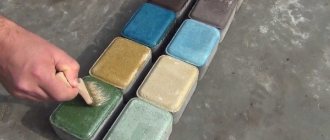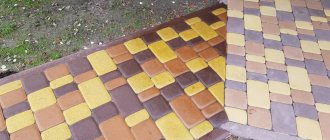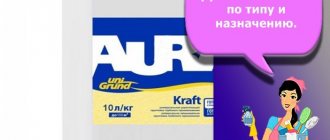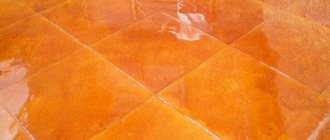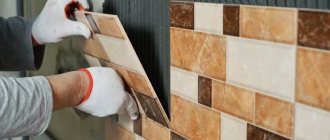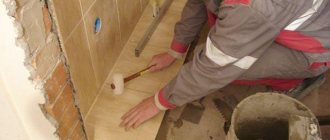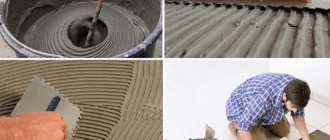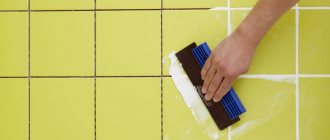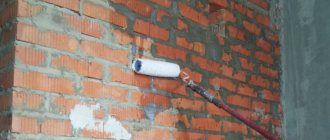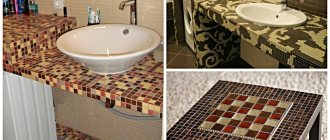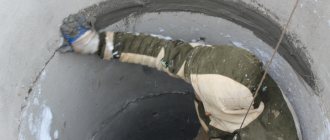On pedestrian zones, bicycle paths, squares and parks of modern streets, you almost no longer see dull gray asphalt. It was replaced by such a new material as paving slabs. Possessing a wide variety of shapes, colors, affordable prices and simple installation, these man-made paving stones have become very popular in the design of personal plots.
However, despite all the advantages, this material has one significant drawback - like all concrete structures, this material is very damaged when exposed to moisture.
This deficiency of the material can be eliminated and protected from the destructive effects of moisture using a water repellent for paving slabs - a special impregnation applied to the surface of concrete and forming a dense water-repellent film.
Figure 1. Water repellent for paving slabs
Why treat already laid tiles?
Treatment with a water repellent allows:
- protect the material from moisture;
- make concrete more durable and resistant to mechanical stress;
- increase the frost resistance of the coating;
- protect the coating from the appearance of growths of moss and lichens
- prevent the formation of efflorescence;
- increase the abrasion resistance of the coating;
- increase the service life of the coating;
- reduce the frequency and quantity of repair work;
- give the tiles a more saturated color.
Figure 2. Paving covering with a water-repellent composition applied to it
Material properties
Organic and waterborne acrylic varnishes, in general, have similar properties:
- Possibility to use for external and internal work;
- significant strengthening of the surface and structure of brick, paving slabs, concrete, natural and artificial stone, and other coatings based on mineral materials;
- weather protection;
- hydrophobization of the surface and protection against moisture penetration inside;
- decorative appeal: color saturation, shine;
- high degree of adhesion, deep permeability;
- insensitivity to biological and chemical environments;
- insensitivity to UV, temperature changes;
- resistance to mechanical loads, low susceptibility to abrasion;
- extending the service life of structures made of brick, tile, and decorative stone.
Ways to protect paving slabs
To protect paving slabs, the following highly specialized solutions and impregnations are used:
- decorative - impregnations that serve to improve the appearance of the coating, giving it rich color and shine;
- cleaning – special solutions designed to remove traces of various contaminants (small particles of soil, oil, fat, salt deposits), lichen growths, moss from the surface of the material;
- antifungal – antiseptic solutions that prevent the development and spread of various microorganisms on the surface of garden paths and sidewalks;
- water repellents – solutions that increase the resistance of the material to moisture, increasing the strength and frost resistance of the tiles.
Types of coatings
Impregnation for paving slabs or stone wall cladding is divided into several groups. The main criteria for classification are operating conditions, functional impact, decorative component. Thus, materials are used for work inside or outside a building, for finishing surfaces with various mechanical loads: for the floor, pedestrian area or walls.
According to their intended purpose, there are 3 groups of funds:
- water repellents that help increase the resistance of paving stones to moisture and temperature changes outside;
- antiseptics, which are often used to treat joints between masonry elements;
- cleaners for removing dirt, efflorescence, oil and grease stains, and deposits.
A separate group of materials are varnishes and impregnations for stone, which provide a coating with a wet effect. These materials are divided into three types based on application. A common property is the ability to penetrate deeply into the working base.
Varnish “wet stone” Source wooood.ru
For outdoor work, the main characteristic is resistance to climatic operating conditions and high wear resistance. Health safety and resistance to household detergents are important for the premises. Universal compositions are made using acrylic or latex binder. Organic solvents in the impregnation quickly evaporate, can cause an allergic reaction, and emit an unpleasant odor while the coating dries. Therefore, it is better to use them outdoors.
Types of varnish for paving slabs with a wet effect and which one is better
In addition to the water repellent, partial protection of this material from moisture, as well as improving the appearance of the coating, is provided by a varnish with a wet effect. The most common and widely used acrylic varnishes are of two types:
- water-based - do not contain toxic components harmful to health, which is why they are used for processing tiles in garages and gazebos;
- solvent-based - such varnishes are used for application to areas of paving surfaces located in the open air (garden paths, garage driveways, areas around gazebos, porches).
Figure 3. Acrylic varnish on the sidewalk
Important. Solvent-based varnishes cannot be used indoors - the volatile components they contain can cause damage to the respiratory system, the mucous membrane of the eyes, and the skin. The fumes from this composition can be dangerous even when applied to outdoor garden paths. Therefore, in order to avoid poisoning and eye damage, even with small amounts of work, it is necessary to use a respirator and safety glasses.
Polymer varnish for concrete, stone, brick with a “wet stone” effect
- versatility and ease of application
- exceptionally high weather resistance
- provides wear resistance and low abrasion
- protection of concrete from corrosion
- excellent decorative qualities
- has a “wet stone” effect
- semi-gloss
- in 3 hours - small order
- next day - big order
- 3-5 working hours days - for goods on order
- In Moscow within the Moscow Ring Road - from 500 rubles.
- In the Moscow region beyond the Moscow Ring Road - 500 rubles + 20 rubles/km.
- We deliver goods throughout Russia! We deliver free of charge to TK terminals (in Moscow)
More details
- Description
- Application
- Characteristics
- Documentation
- Reviews
Texol is a wear-resistant polymer varnish for protecting concrete, stone, brick, and tiles.
Texol varnish is a one-component, quick-drying varnish based on acrylic copolymer and alkyd resin in a mixture of organic solvents with the addition of targeted additives.
Polymer varnish is recommended for use wherever there is a need to protect mineral materials (concrete, mortar, brick, stone) from corrosion. The varnish is both protective and protective-decorative (has a pronounced “wet stone effect”) with excellent wear resistance and abrasion characteristics.
Texol varnish forms a durable coating on the surface that is resistant to atmospheric and mechanical loads. Polymer varnish has a universal set of properties. Among them, we should highlight such undoubted advantages as the ability to quickly cure and the possibility of application at sub-zero temperatures.
Purpose
Texol polymer varnish is used for protective and decorative finishing of concrete and mosaic floors, paving and facing tiles, natural and artificial stone, decorative paving stones, curbs, bricks and other surfaces exposed to atmospheric influences.
Texol wet stone varnish is also suitable for industrial and warehouse areas for application to concrete floors.
Attention!
- Supplied in lithographed containers!
- The label is equipped with protective elements against counterfeiting!
Mode of application
The varnish is ready for use. If necessary, dilute to working viscosity with a solvent: solvent, butyl acetate, R-Universal.
Apply to a dry, clean surface with a spray, brush or roller in one or two layers.
Temperature conditions for applying varnish: from -20˚С to +35˚С.
Drying time at a temperature of +20˚С is 4 hours .
Consumption
The varnish consumption is 0.25-0.3 kg per 1 sq.m. depending on the type and type of surface.
Precautionary measures
When carrying out interior work, as well as after completion, thoroughly ventilate the room. Use personal protective equipment.
Procedure for processing tiles
The process of applying water repellent does not require special skills or experience. You just need to purchase the necessary materials, prepare the tools, clean the work surface, and then carefully apply several layers of impregnation to it.
Required materials and tools
The following materials will be required for this type of work:
- water repellent;
- acrylic decorative varnish with wet stone effect;
- special detergents for the care of paving slabs (solvents for removing efflorescence and dirt).
To clean the work surface and apply a protective and decorative layer, you will need the following tools:
- a brush or broom with plastic rods;
- wide brush or hand sprayer;
- 2 buckets for water repellent and varnish;
- roller;
- rags.
Application process Water repellent for paving slabs
Applying a water-repellent layer consists of 4 main steps:
- Cleaning the working surface from large debris - sand, soil particles.
- Removing efflorescence and grease stains from the work surface.
- Applying 1-2 layers of water repellent using a spray gun or a wide brush.
- Applying a decorative layer (varnish with a wet stone effect) using a roller.
Varnish Wet stone
The Wet Stone effect for paving slabs can be achieved using a special varnish. The product is sold ready-made, but must be mixed before use. If the consistency is too viscous, you can dilute the varnish using a special gasoline solvent (white spirit).
The varnish is applied to the surface with a roller or paint brush. To give the effect of Wet Stone for paving slabs, the varnish is applied in 2 or 3 layers. A certain amount of time should pass between applying each layer (6 to 8 hours).
You need to wear a respirator when working with varnish to avoid poisoning and allergic reactions. Try to ensure that there are no open flames nearby while working, because the product is highly flammable. If the surface is treated with varnish indoors, then periodic ventilation is necessary.
The varnish used for processing paving slabs is durable and practical. There are several varnish options:
- water based;
- silicone based;
- acrylic varnish impregnation.
The water-based product quickly wears off and becomes deformed, because its structure does not allow it to penetrate into the deep pores of the tile material. Silicone and acrylic impregnation, on the contrary, will provide reliable protection for the pavement surface.
The varnish used as an impregnation for tiles has the following advantages:
- protects from exposure to sunlight;
- serves as protection against winter reagents (salt, alkalis, acids), as well as against gasoline and oil stains;
- prevents the formation of cracks and chips;
- increases the service life of the pavement covering material;
- prevents mold;
- easy material to use;
- environmentally friendly product;
- internal and external surfaces can be processed;
- transparent consistency.
Varnish with the Wet Stone effect can be used at any temperature, even below freezing, which makes it possible to use the product in any climatic conditions. Thanks to the transparent consistency of the varnish, after its application, the tiles retain their original color and the surface is easy to clean.
How is varnish applied?
To treat tiles with impregnating varnish, you do not need to carry out special preparatory measures. There is also no need to purchase additional materials and equipment for work.
To process the paving surface, you must perform the following steps:
- clean the tile surface well;
- apply several layers of varnish, at certain intervals, using a roller or brush;
- the treated surface must be left for two weeks until completely dry;
- tiles with a porous structure are processed in a large number of layers;
- It is recommended to treat the surface in dry times.
Important: in order for the impregnation varnish to cope with its stated task, it must be used at a temperature of at least 10 degrees Celsius.
Water repellent or tile varnish: which is better?
When choosing between these two protective solutions, a multifunctional water repellent is more advantageous and reliable. This is explained by the fact that, compared to decorative varnish, this moisture-proof material has the following advantages:
- it more effectively protects the paving surface from moisture and abrasion;
- The resistance of the water repellent to aggressive substances is much higher than that of decorative varnish;
- a water-repellent layer applied to the working surface of the sidewalk increases its mechanical strength;
- the cost of both the water-repellent impregnation itself and the work required to apply it is significantly less than that of acrylic decorative varnish.
Compositions for the protection of mineral surfaces
Acrylic-silicone
- weatherproof
- water- and dirt-repellent (with “lotus” effect)
- semi-matte
Solvent acrylic
- weatherproof
- waterproof
- semi-gloss
Water-repellent impregnation for stone and brick
- reliably protects against moisture
- increases surface frost resistance
- contains an effective antiseptic
For mineral surfaces
- effectively removes salt stains
- leaves no marks when drying
- can be used to clean ceramic tiles
Against mold and mildew
- highly effective against all types of biological lesions
- Can be used on any type of surface
- Suitable for both lesion removal and preventive treatment
Most building materials are highly porous and susceptible to swelling due to capillary absorption of water.
Popular hydrophobic solutions
Among the wide variety of moisture-proof solutions for treating paving slabs, the most popular are the following brands:
- "Aquasil";
- "TipromU";
- "Crystallizol";
- "Ceresit ST 10,11,12,13";
- "VOKA".
Figure 4. Characteristics of popular water repellents for paving slabs
How to protect concrete paving slabs
They laid a platform and paths made of concrete paving slabs in two colors: gray and brick. The quality of the tiles turned out to be very poor, because... we took it from local manufacturers, who, as it turned out, make it “in the best way possible.” Now the task is to somehow strengthen the already laid tiles on top and extend its life. Question: what can be done, what compositions exist for this?
Materials for protecting (painting, impregnating) concrete paving slabs or stones (paving stones) can be divided into two main groups:
- Waterproofing agents are coating compositions - colored paints and impregnating varnishes in varying degrees of transparency, creating on the surface of the tile (stone) a waterproof and wear-resistant layer of the appropriate color or with a “wet stone” effect.
- Water repellents (hydrophobic impregnations) are compositions that give the outer surface of the tile (stone) and the internal surfaces of its pores water-repellent properties at the molecular level and do not change the appearance of the tile or create a weak “wet stone” effect on it.
Special paints and varnishes for concrete with high abrasion resistance (wear resistance) can be used as a waterproofing agent for paving slabs. There are dozens of such products, and according to their chemical composition they can be divided into the following types:
— Rubber paints (acrylic aqueous solution), characterized by increased elasticity and resistance to temperature fluctuations. Rubber (acrylic) paints are odorless and absolutely harmless.
— Alkyd paints and varnishes for concrete, which, in addition to waterproofing properties, also have high chemical and mechanical resistance. Alkyd compounds have a pungent odor that lasts for a long time.
Tips for using impregnation
- all work on applying water repellent is carried out in moderately warm and windless sunny weather;
- after heavy rainfall, application should be made after the working surface has completely dried;
- Before applying impregnation, be sure to inspect the seams between the tiles, filling the voids;
- You can check the quality of the applied moisture-protective layer by pouring a little water onto the working surface - if the solution has been distributed efficiently and evenly over the surface of the concrete, the water will collect in small puddles and flow towards the slope.
Technology for creating comprehensive protection
Organizing and carrying out work to create effective comprehensive protection for paving will ensure the presence of a durable protective film that simultaneously performs several important tasks. Its creation is best started before laying the tiles.
First of all, using detergents, it is necessary to thoroughly clean the material from dust and dirt. If the path or platform has already been laid, then we clean the finished surface.
The process of applying water repellent.
Next, you need to pour the hydrophobic composition into a wide container and put the tiles in it for 5-7 minutes, then remove and dry. The water repellent is applied to the laid coating with a roller, paint brush or spray. All subsequent operations are performed only after laying the tiles.
The third stage of work includes painting the paving surface with a special varnish, which allows you to obtain the original “wet stone” effect, emphasizing its color shade.
This treatment is often used for paving stones that have become dull after long-term use. It is recommended to pre-treat the new coating with a hydrophobic solution to increase the moisture resistance and frost resistance of the stone.
To protect the tile joints from the formation of fungus and mold, they must be filled with frost-resistant sealant. This will not only avoid the occurrence of biological formations, but also protect the paving surface from increased penetration of moisture into the bulk base material and subsequent swelling during the cold season.
This set of measures makes it possible for a long time to avoid the accumulation of moisture in the tile material, erosion of seams, fading of tiles, settling of dirt on the surface, and destruction of concrete materials from exposure to alkaline and acidic solutions. High-quality protection makes it possible to achieve a more attractive appearance and durability of sidewalk coverings.
Benefits of post-processing
Complete care must include the use of special impregnations or decorative varnishes with a “wet stone” effect. Timely application of a water-repellent layer can solve a lot of problems.
Even the most expensive and high-quality tiles are not easy enough to clean. A decorative or protective coating will help:
- significantly extend the service life and significantly simplify the maintenance of tiles;
- improve the natural appearance of the stone;
- give it a more beautiful color and matte shine;
- get a wet effect on a completely dry surface;
- make the road surface and its blind area resistant to mechanical damage and abrasion;
- make the tiles safe to use thanks to a special anti-slip impregnation;
- prevent serious dirt or unsightly stains from appearing in the future;
- create reliable protection against mold or moss;
- provide a reliable barrier to ultraviolet rays;
- prevent fading of natural color.
A timely treatment procedure before or after installation will help you forget about these problems for up to 5 years. This will help the coating look perfect at any time of the year with much less time, effort and financial resources spent on caring for it.
